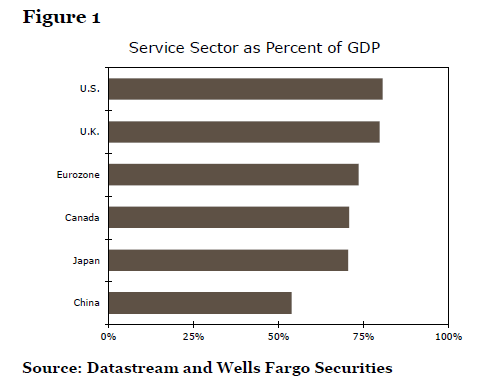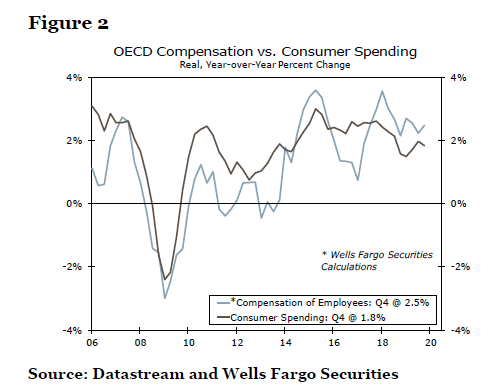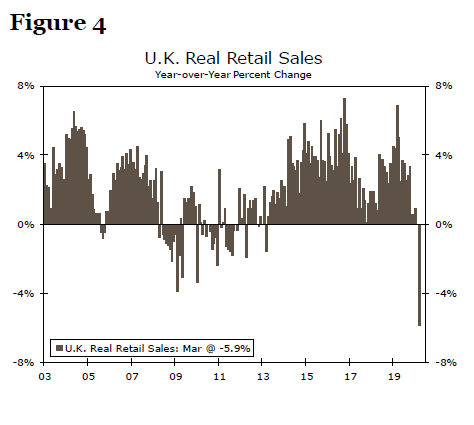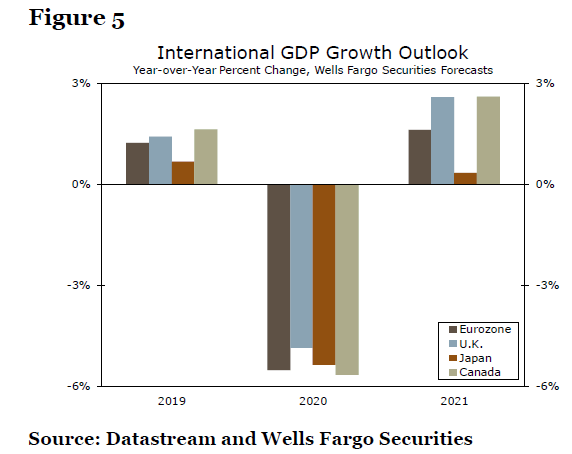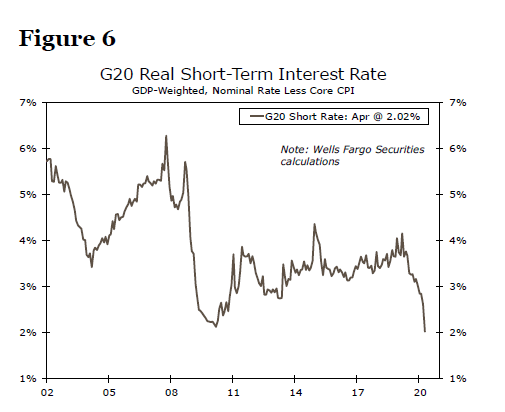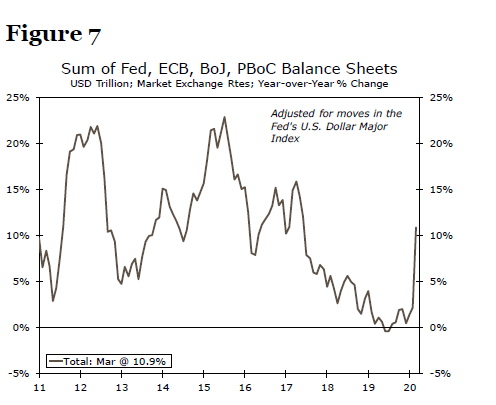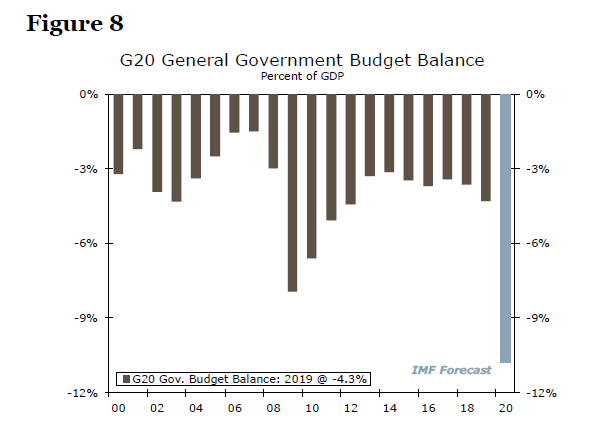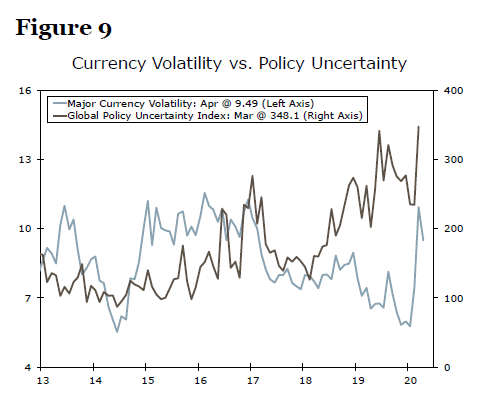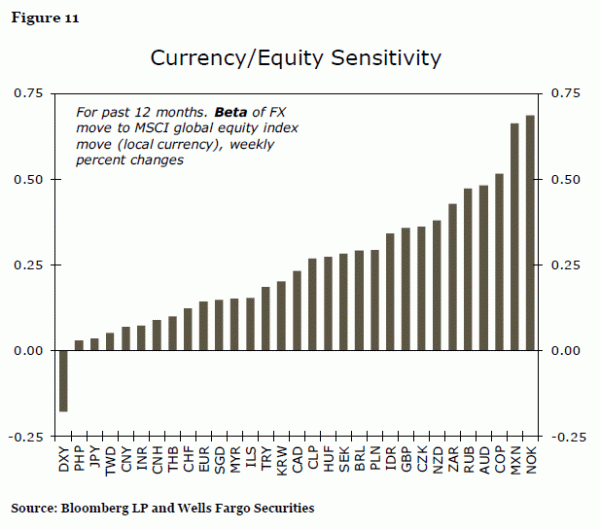Executive Summary
- As 2020 progresses, evidence continues to mount on the severe damage COVID-19 and associated lockdown measures are causing to the global economy. We expect an essentially synchronized contraction for all the major foreign economies we monitor and see global GDP declining 2.9% this year. While there is increasing clarity on the extent of the downturn, the outlook for the subsequent recovery remains less clear.
- Monetary policymakers have responded aggressively with interest rate cuts, quantitative easing and other measures to provide liquidity and improve market functioning. Fiscal policymakers have implemented large scale spending and revenue measures, along with loans and guarantees. While these measures should help households and corporations, we don’t think they will help enough to avoid recession.
- FX markets remain somewhat unsettled, suggesting the U.S. dollar and yen should remain outperformers for now. In contrast, given the weakening global backdrop, we see the Canadian dollar, Singapore dollar, Chilean peso, Mexican peso, rupee and rand as underperformers in the period ahead. Over the much longer term, once the global economy and markets stabilize, many G10 and emerging currencies should show more sustained gains
As COVID-19 Spreads, So Does Economic Damage
The early part of 2020 has been dominated by COVID-19 and its spread across most countries, along with government efforts to contain the virus’ spread. In most cases, government responses have entailed locking down large portions of their respective economies to limit the transmission of the virus, significantly affecting households and businesses. To a lesser extent, the collapse in global oil prices, initially sparked by a price war between Russia and Saudi Arabia, has also influenced the outlook. As the year has progressed, the expected negative economic effects from COVID-19 have intensified, and the channels through which COVID-19 is expected to impact the global economy have evolved.
In mid-January, in what we would consider to be a ‘pre-COVID’ forecast, we expected global GDP growth of 3.0% in 2020 and 3.3% in 2021. Fast forward to April, and in our latest international economic forecast published mid-month, we now expect the global economy to contract 2.9% in 2020, before growth rebounds moderately to 3.3% next year. Conceptually, the swing in the GDP outlook represents a significant loss in global income. Gross Domestic Product represents the value of goods and services produced in an economy and is typically calculated in one of three ways:
- A production approach, which measures the value of output by industry sector.
- An expenditure approach, which measures spending by the private and public sector on goods and services.
- An income approach, which measures income accruing to various economic sectors (e.g., households, corporates and the government sector).
Although calculated differently, these three approaches to determining GDP should give a theoretically equivalent result. Thus, the swing in our GDP outlook between January and April of this year represents a significant reduction in income accruing to households, business and the public sector. Indeed, given the IMF estimated that global GDP was US$86.6 trillion in 2019, a swing from 3% global 2020 GDP growth in January to a 3% global GDP decline in April represents an ‘income gap’ of around US$6 trillion, despite the best efforts of economic policymakers to limit the damage.
Not only has the expected negative economic effects of COVID-19 risen exponentially since the beginning of this year, but the channels through which those negative effects are transmitted have also evolved. China was the first major economy to be affected by the outbreak, and the initial analysis focused primarily on the economic transmission of COVID-19. That is, this type of analysis was primarily on supply chain risks in terms of imported immediate goods, or trade/export exposures to China
Now that COVID-19 has spread through most major economies, including Europe and the United States, we would argue the focus has shifted primarily to the biological transmission of the COVID-19 response and the consequent government actions. That is, as the virus has spread across the globe governments have reacted to the spread of the virus by shutting down large portions of their economies, and in particular the service sector. For example, transportation, recreation activities, restaurants and retail are among some of the sectors that have been severely affected. In this analysis, the economic linkages between countries becomes somewhat less important, and instead the structure of the domestic economy becomes more influential. The risks to the major western developed economies are magnified sharply, in this scenario, where the service sector often accounts for 70% to 80% of the economy in those countries and regions (Figure 1).
Another perspective that suggests service sector activity is at significant risk is to assess the outlook for household incomes and consumer spending. Through much of 2019, the consumer sector was solid on the back of employment gains and wage growth, while economic concerns were more focused on the manufacturing sector as a result of global trade tensions. For 2020, there has been something of a role reversal. The outlook for manufacturing activity has not exactly improved. However, with significant job losses currently taking place around the world and more in prospect, we expect a sharp drop in household incomes. Figure 2 compares (inflation-adjusted or ‘real’) compensation of employees versus consumer spending for the OECD group of economies. Whereas employee compensation has been growing more quickly than consumer spending for several quarters—arguably supportive for the consumer sector—in 2020, we anticipate a sharp decline in employee compensation will be a significant drag on consumer spending
Dreadful Data Continue to Accumulate
The evidence pointing to the negative effects of COVID-19, on foreign economies, including specifically on the service sector, has started to accumulate in recent weeks. Of note:
China’s Q1 GDP slumped 9.8% quarter-over-quarter and 6.8% year-over-year, with the secondary sector (i.e., manufacturing) falling more sharply than the tertiary sector (i.e., services). However, March figures suggest a slower rebound in services than industrial activity, as retail sales fell 15.8% year-over-year compared to just a 1.1% decline in industrial output.
In the Eurozone, hard data pointing to a sharp contraction in economic activity are limited so far, although a 60% year-over-year fall in March car registrations gives an indication of what is to come. Meanwhile, confidence surveys make it clear the downturn will be severe, especially in the service sector. After the Eurozone services PMI fell to a record low of 26.4 in March, it slumped to another record low of 11.7 in April and the economy-wide composite PMI also plunged to a record low of 13.5 (Figure 3). The next key near-term release is Q1 GDP for which the consensus forecasts a 3.9% quarter-over-quarter decline, although survey data make it clear there will be a much larger fall in Q2.
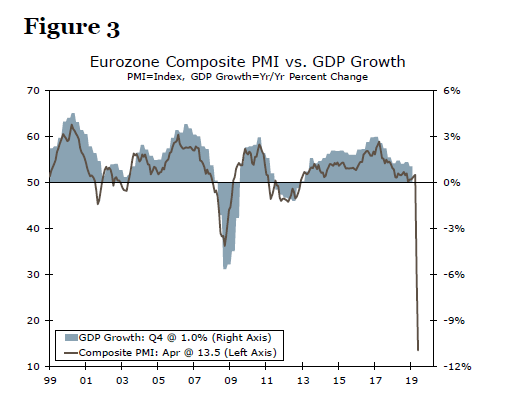 Japan’s economy was already struggling heading into 2020 following the consumption tax hike in October of last year. While confidence surveys clearly point to an even further weakening of activity early this year, the hard data are limited to date. What is clear, however is that Japan’s economy was losing momentum even before the most significant impact from COVID-19. The synthetic consumption index—which is a good proxy for the consumer spending component of GDP—fell 1.5% month-over-month in February. For now, consumer spending appears to be following a similar pattern to the subdued recovery in spending seen after the 2014 consumption tax hike—a tax increase that saw the economy fall into recession.
Japan’s economy was already struggling heading into 2020 following the consumption tax hike in October of last year. While confidence surveys clearly point to an even further weakening of activity early this year, the hard data are limited to date. What is clear, however is that Japan’s economy was losing momentum even before the most significant impact from COVID-19. The synthetic consumption index—which is a good proxy for the consumer spending component of GDP—fell 1.5% month-over-month in February. For now, consumer spending appears to be following a similar pattern to the subdued recovery in spending seen after the 2014 consumption tax hike—a tax increase that saw the economy fall into recession.
U.K. confidence surveys, similar to the Eurozone, have also dropped to record lows. After the services PMI dropped to a record low of 34.5 in March, it slumped further to another record low of 12.3 in April. Moreover, there is also some hard evidence of the early impact of COVID-19 on activity. March retail sales slumped by 5.1% month-over-month and 5.8% yearover- year (Figure 4), with clothing, household goods and auto fuel sales among the largest monthly decliners.
Finally, Canada’s most noteworthy data point so far is the March jobs report, which saw employment fall by a record 1,011,000 and total hours worked slump 15.1% month-overmonth. Meanwhile, Statistics Canada currently estimates that March GDP fell 9% monthover- month
Given widespread evidence of economic weakness, we forecast a global recession in 2020, with every major foreign economy we monitor expected to contract this year. In addition, while there is increasing—but not yet full—clarity on how deep the downturn will be, there is much less certainty on how robust the post-virus recovery will be. We believe the risks are tilted toward a gradual economic recovery, and forecast global GDP growth of only 3.3% in 2021 (Figure 5)..
Policymakers’ Powerful Response
Given the sudden stop in the global economy, policymakers in major economies have stepped up with a rapid and robust response, matching (and possibly exceeding) that seen during the global financial crisis. Our goal here is not to detail a country-by-country response, but instead give a sense of the overall magnitude.
Rapid reductions in policy interest rates across the major and emerging countries. Policy interest rates for all the G10 economies are now either effectively at zero, or in negative territory, while for the G20 economies as a whole, nominal short-term interest rates have dipped below the lows seen around the global financial crisis (Figure 6).
Widespread large scale asset purchases. Many central banks have resumed, or implemented for the first time, asset purchase programs. There have also been other actions to provide liquidity and help market functioning. As a proxy, for example, Figure 7 shows growth in the aggregated balance sheets of four major central banks—the Federal Reserve, Bank of Japan, European Central Bank and People’s Bank of China. We estimate this measure by adjusting foreign central bank’s balance sheets into U.S. dollar equivalents and taking into account strength or weakness in the U.S. dollar to get a sense of underlying growth. The measure shows balance sheet growth had already picked up sharply in March to 10.9% yearover- year from 2.2% year-over-year in February, and will surely quicken further in the months ahead.
On the fiscal policy front, the IMF estimates that governments in major economies have so far announced fiscal spending and revenue measures totaling US$3.3 trillion, while more is likely to come in the weeks and months ahead. For example, the U.S. recently passed another $484 billion fiscal package, while the Eurozone is contemplating future measures. In addition, so far globally the IMF estimates government guarantees of around US$2.7 trillion, and loans and equity injections of around US$1.8 trillion. In its April 2020 Fiscal Monitor, the IMF forecasts G20 economies have an aggregated general government budget deficit of 10.8% of GDP from 4.3% of GDP in 2019 (Figure 8). That is a significant increase in budget deficits, and a much larger increase than during the global financial crisis.
Still, despite these pronounced efforts by policymakers, and as we alluded to earlier, we do not believe it will help enough to fill the ‘income gap’ and avoid global recession. That is, the decline in global GDP implies a decline in global incomes. Rather, these policy actions at least in part have the effect of transferring income from the government sector to the household and corporate sector—without these significant policy actions, private sector activity would be even weaker.
Maintain Foreign Currency Caution for Now
What are the implications of this economic and financial market backdrop for foreign exchange markets? So far in 2020 the U.S. dollar has been a strong performer, with gains against most G10 and emerging currencies since the start of this year. In part that reflects a severe global U.S. dollar shortage when market stresses were at their peak. In addition the actions by the Federal Reserve is making dollar liquidity more readily available both in the United States and globally, which appears to have substantially alleviated those funding strains. Nonetheless, foreign exchange markets remain somewhat unsettled (as reflected by still elevated implied currency volatility), in part because the policy outlook (and to a lesser extent the economic outlook) remains uncertain (Figure 9). In this environment we believe the U.S. dollar and Japanese yen will outperform in the near-term.
That said, even with the easing in the U.S. dollar shortage, the fundamental backdrop underlying the foreign currency outlook has become far less constructive in recent months. Those less constructive elements include the prospect of a sharp economic recession in 2020, the potential for further volatility in global equity markets, and a dramatic collapse in global commodity prices since the beginning of the this year (Figure 10). To be fair, we believe a very negative economic and market outlook has already been priced into foreign exchange markets to a significant extent. Nonetheless, in this environment we view the Canadian dollar, Indian rupee, Singapore dollar, Chilean peso, Mexican peso and South African rand as likely underperformers. More generally, we see little reason to expect meaningful gains for most G10 and emerging currencies versus the greenback for the time being.
However, over the longer term we see potential for the greenback to weaken, especially given the massive injection of U.S. dollar liquidity in recent weeks and as the global economy and global markets stabilize. Figure 11 shows the sensitivity of currency movements to movements in equities (the MSCI global equities index). Specifically for the past 52 weeks, we used regression analysis to estimate the sensitivity of weekly percentage changes in FX movements to weekly percentage changes in equity markets, with the regression coefficient or ‘beta’ capturing the sensitivity of FX moves to equity market moves.
Our results indicate that over the past year the U.S. dollar has been the ‘safest haven’ with a beta of -0.18, meaning that every 10% decline in global equities tends to be accompanied by a 1.8% gain in the U.S. dollar index. The yen has also been relatively ‘safe,’ with a beta of just +0.035. Many other currencies, however, have been sensitive to equity turmoil, in some cases markedly so. For example, the Norwegian krone, Mexican peso and Chilean peso have betas ranging between +0.50 to +0.70, meaning every 10% decline in global equities has tended to be accompanied by a decline of 5%-7% in the Chilean peso, Mexican peso and Norwegian krone versus the greenback.
Once the global economy and markets eventually stabilize over the longer term, we expect most emerging currencies to enjoy more sustained gains versus the U.S. dollar, while a more stable longer term outlook should be helpful for many G10 currencies as well.




